Stargazer cast iron skillets have long handles, flared rims, and smooth cooking surfaces.
But are those unique features worth the higher price? What makes Stargazer better than a $30 skillet?
In this review, I break down the pros and cons of Stargazer cast iron skillets.
You’ll learn:
- How they look, feel, and perform (with video and lots of pictures)
- Their downsides
- How they compare to the competition
- And much more
So if you’re thinking about buying a Stargazer cast iron skillet but need an unbiased review to help you decide, keep reading.
Use the links below to navigate the review:
- Stargazer Review: Video Summary
- Design
- Cooking Performance
- Heat Conduction and Retention
- Sizes
- Weight
- Materials and Construction
- Company History
- Price
- Downsides
- What Others Say About Stargazer
- FAQs About Stargazer
- Bottom Line: Is a Stargazer Cast Iron Skillet Worth It?
Stargazer Review: Video Summary
Watch me break down the pros and cons of Stargazer cast iron skillets in this video review.
Design
The best way to explain Stargazer’s unique design is to show you. Let’s take a close look using the 12-inch skillet as the example.

Exterior
Each Stargazer Cast Iron skillet is hand-seasoned with two coats of a blend of canola, grapeseed, and sunflower oil. This results in the unique signature bronze color (most pre-seasoned cast iron skillets are black).

The bottom of the skillet is slightly concave, but it’s so subtle that you won’t notice it. The pan isn’t warped — there is a purpose behind this design.
Peter Huntley, the founder of Stargazer, explains it in this video. He says the pan’s bottom is mostly flat for optimal contact with the stove. But it’s slightly concave, so it won’t rock around when the bottom of the pan deflects heat.
The date the skillet was cast is stamped on the bottom side of the helper handle. While it doesn’t affect the pan’s performance, it adds keepsake value since cast iron pans can last for generations.

On the underside of the pan, “STARGAZER CAST IRON” is written above the star. To the star’s left, it says “MADE IN USA,” and to the right, the product code. Below the star is the size of the pan listed in both inches and centimeters.
The pan’s exterior has the typical rough texture you’d expect from a cast iron skillet.
Interior
The interior sets Stargazer apart from other cast iron skillets. The pan’s interior is machined to the optimal thickness, and the surface is finished by hand to improve the smoothness.

The pan’s rim is flared, which makes drip-free pouring from all angles easier. Most cast iron skillets have two pour spouts, limiting the angle you can pour liquids.
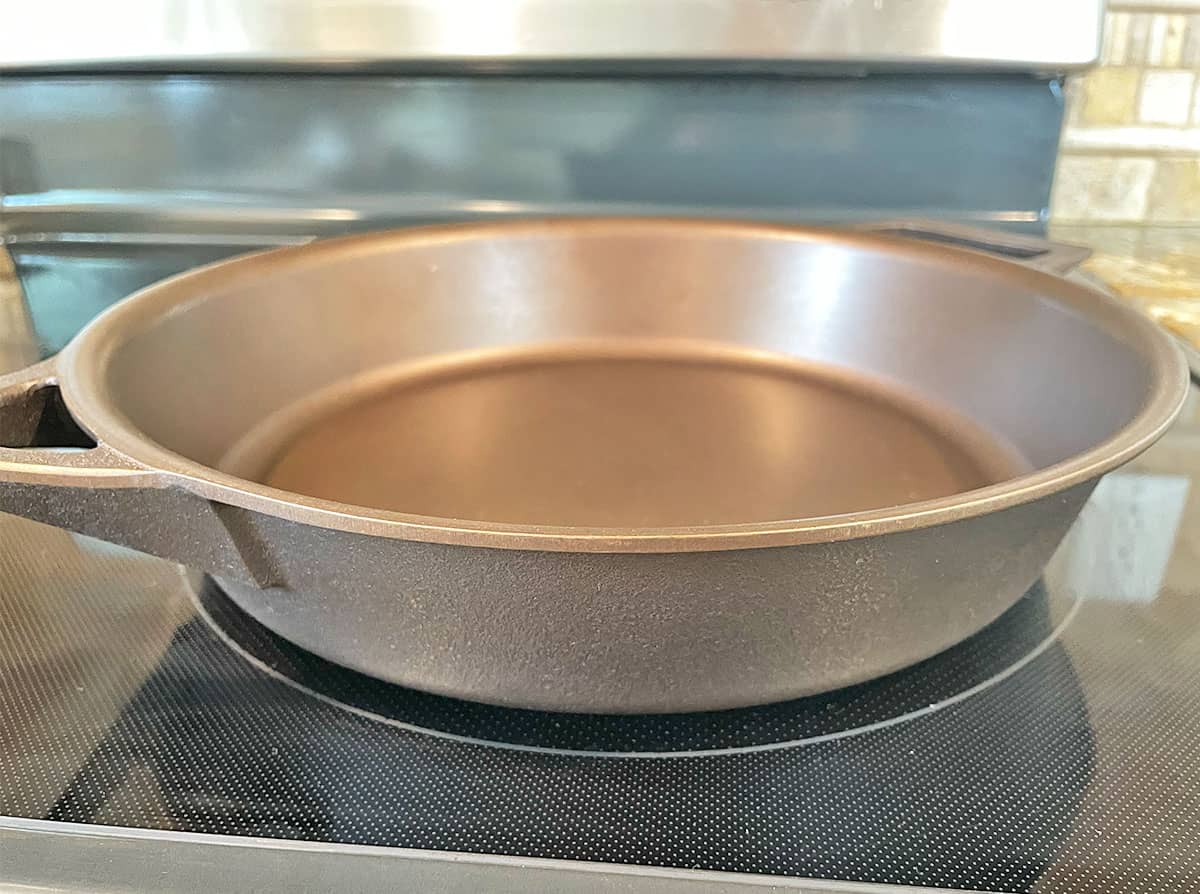
Handles
Stargazer makes its handles longer and thinner than other cast iron manufacturers. The added length allows you to keep your hand further from the burner, and the fork towards the end disperses heat to minimize heat transfer from the skillet’s body.

They also have a unique cup-shaped design that looks like a ‘U’ on top. They remind me of a wider version of All-Clad handles.

This design reduces the risk of slipping when tilting the pan, a problem typical of rounded handles.

Unfortunately, Stargazer handles aren’t the most comfortable. The curved part can dig into your hand, especially if it’s filled with food or you’re holding it for a long time.
Besides the longer handle, Stargazer skillets also have larger helper handles.

The helper handles allow you to carry the pan from the front and the back and distribute the weight evenly when you’re carrying it. You’re less likely to drop the pan or spill liquids while moving it.
Cooking Performance
I’ve been cooking with the Stargazer cast iron skillet for several months, and the overall performance is excellent.
I’ve used it to cook steak, chicken, fish, bacon, pork chops, eggs, and vegetables, and every time the food comes out excellent.
Like any other cast iron skillet, it takes a little while to heat up, but once it’s hot, it retains heat well. It’s an ideal skillet for searing and roasting meats because the temperature doesn’t fluctuate as you add ingredients. It stays hot and cooks evenly.
As you can see below, it does a fantastic job searing and roasting chicken, salmon, and steak.



Although you can get similar results with other (much cheaper) skillets, Stargazer is unique in a few ways.
First, since the handle is an inch or two longer than most, it stays cooler on the stove. Also, the handle’s Y-shaped design helps disperse heat.
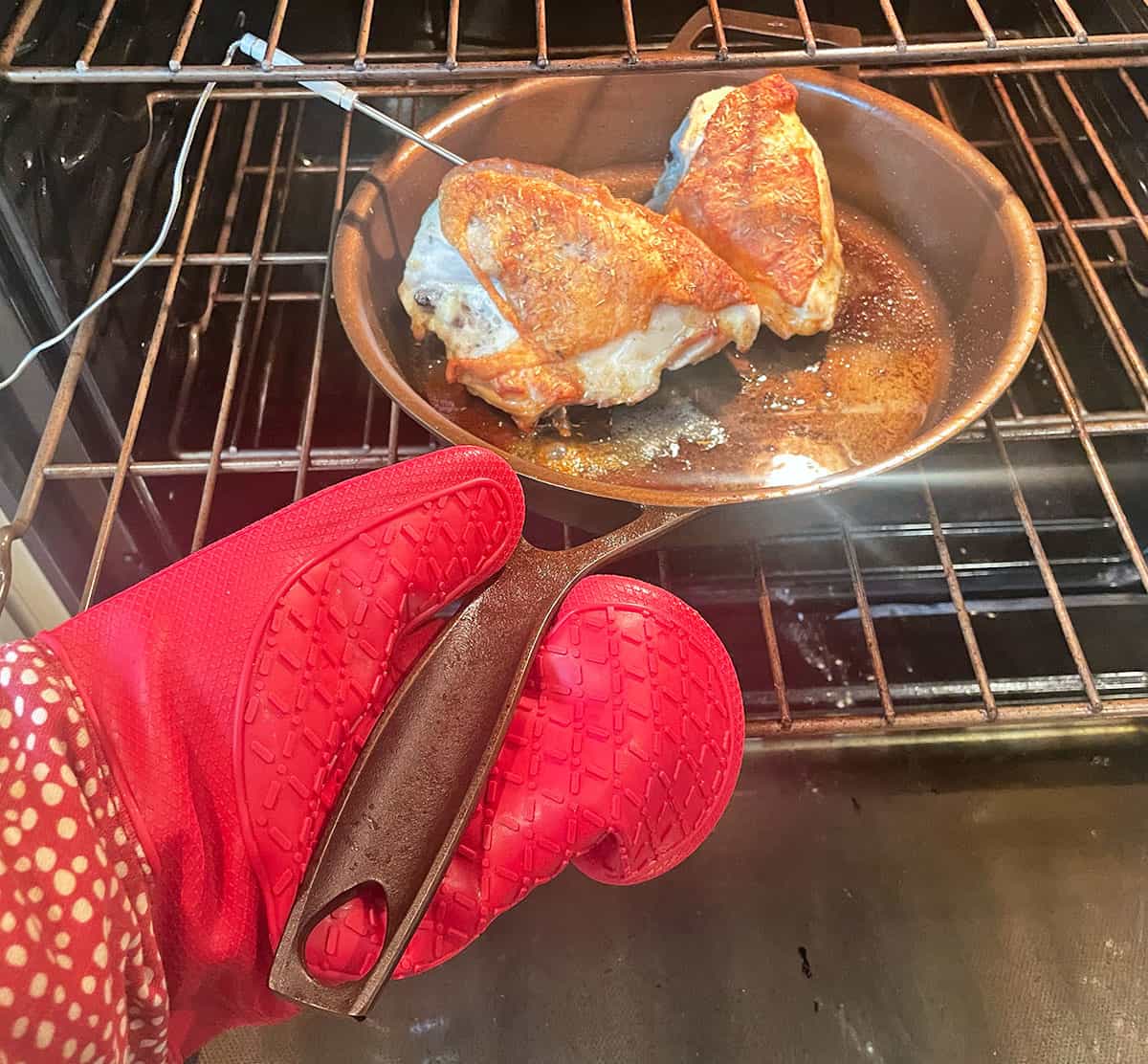
Second, it heats faster than most skillets I’ve tested. The walls are slightly thinner than brands like Lodge, and because of that, heat distributes faster. If you’re in a hurry, you’ll appreciate the extra minute you can save.
Lastly, the cooking surface is noticeably smoother than cast iron skillets such as Lodge and Calphalon. With a few layers of seasoning, the surface becomes almost as slick as a non-stick pan. This is a major benefit if you plan to cook eggs in your cast iron skillet.
My experience testing Stargazer wasn’t completely positive.
After cooking with Stargazer a few times, the seasoning started to degrade, exposing the gray iron underneath. If you buy this skillet, I recommend applying two to three extra layers of seasoning before you begin cooking (here’s the easiest method).

Also, the cup-shaped handle design prevents your hand from rotating when you tilt the skillet, but the edges on each side dig into your hand. The handle would be more comfortable if it were flat rather than cupped. It reminds me of a larger version of All-Clad handles, which people often complain about.
Overall, Stargazer performs as well as any cast iron skillet I’ve tested, plus it features unique perks like the longer handle, smoother surface, and flared rims.
Heat Conduction and Retention
In addition to my real-world testing in the kitchen, I also conducted two quick experiments to see how Stargazer’s heat conduction and retention compare to the competition.
First, I poured three cups of cold water into the skillet. Then I placed it on the stove and turned the heat to high.
My goal was to see how quickly the water boiled and how evenly the heat distributed across the cooking surface.
The water started bubbling after 2 minutes and 48 seconds and came to a full boil after 3 minutes and 24 seconds.
As the water heated, bubbles appeared first in the center but were eventually distributed evenly across the cooking surface.
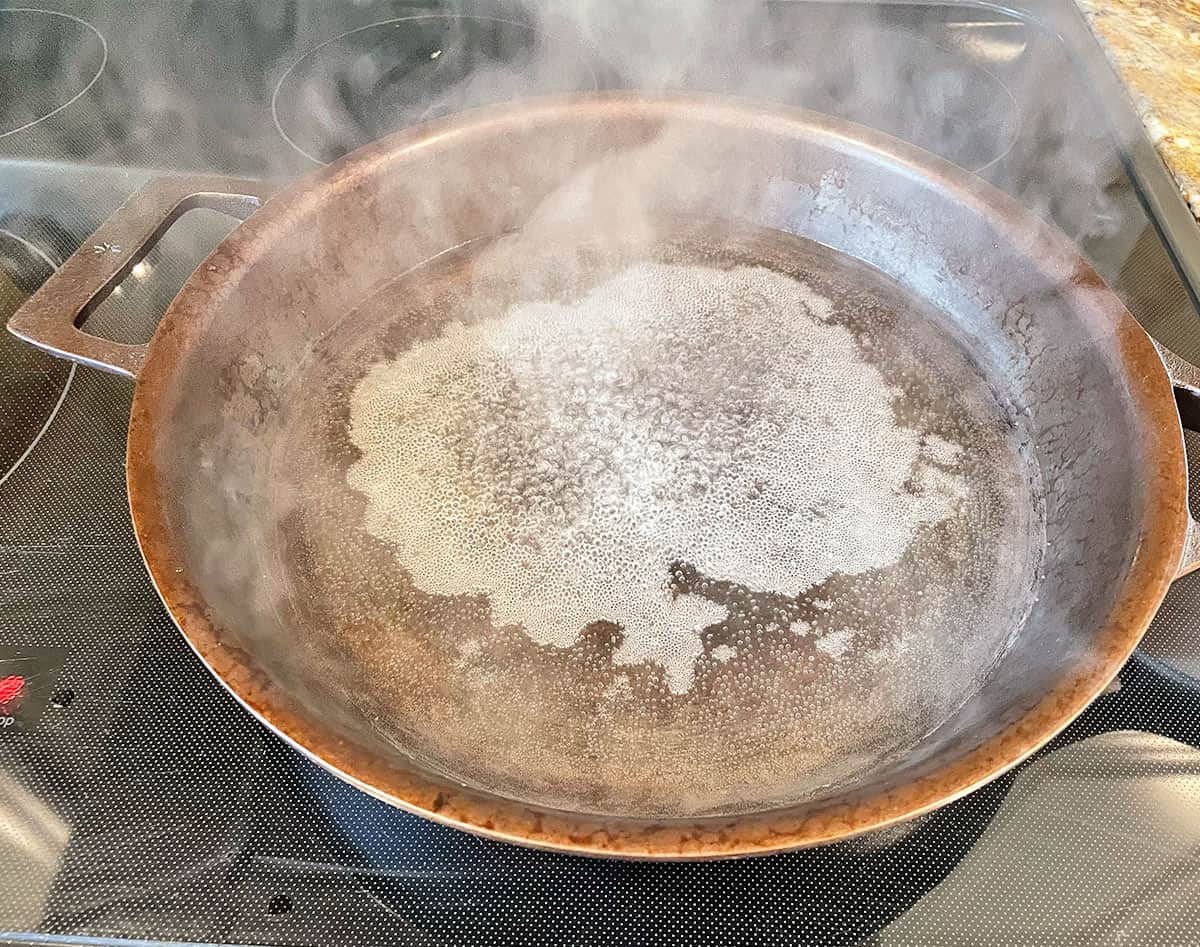
Cast iron’s thermal conductivity is significantly lower than other cookware materials like aluminum and copper; therefore, it doesn’t heat up as fast or evenly. It’s normal to see hot and cold spots as the skillet heats.
I repeated this test with two other popular skillets: Calphalon and Lodge. Water in the Lodge skillet took 4 minutes and 45 seconds to boil, and the Calphalon skillet took 4 minutes and 16 seconds.
These results validate what I observed in the kitchen: Stargazer heats up faster than most cast iron skillets.
The second experiment measures heat retention, which is important for searing steaks, burgers, and other meats. You want a pan that stays hot as you add cold ingredients so they sear and cook evenly.
After boiling the water, I removed the skillet from the stove and placed it on the counter to cool.
After five minutes, the water was 124°F.
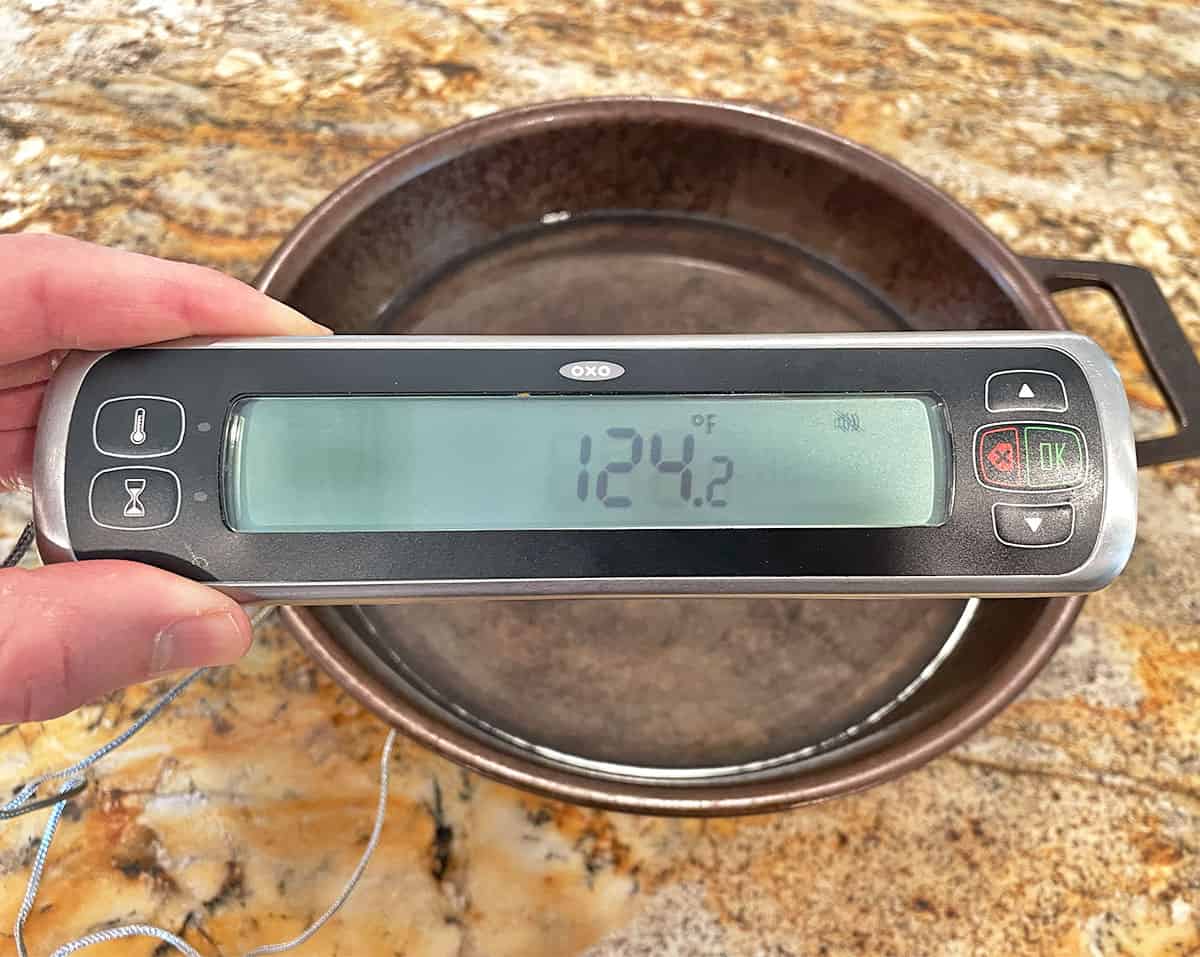
After ten minutes, the water was 109°F.
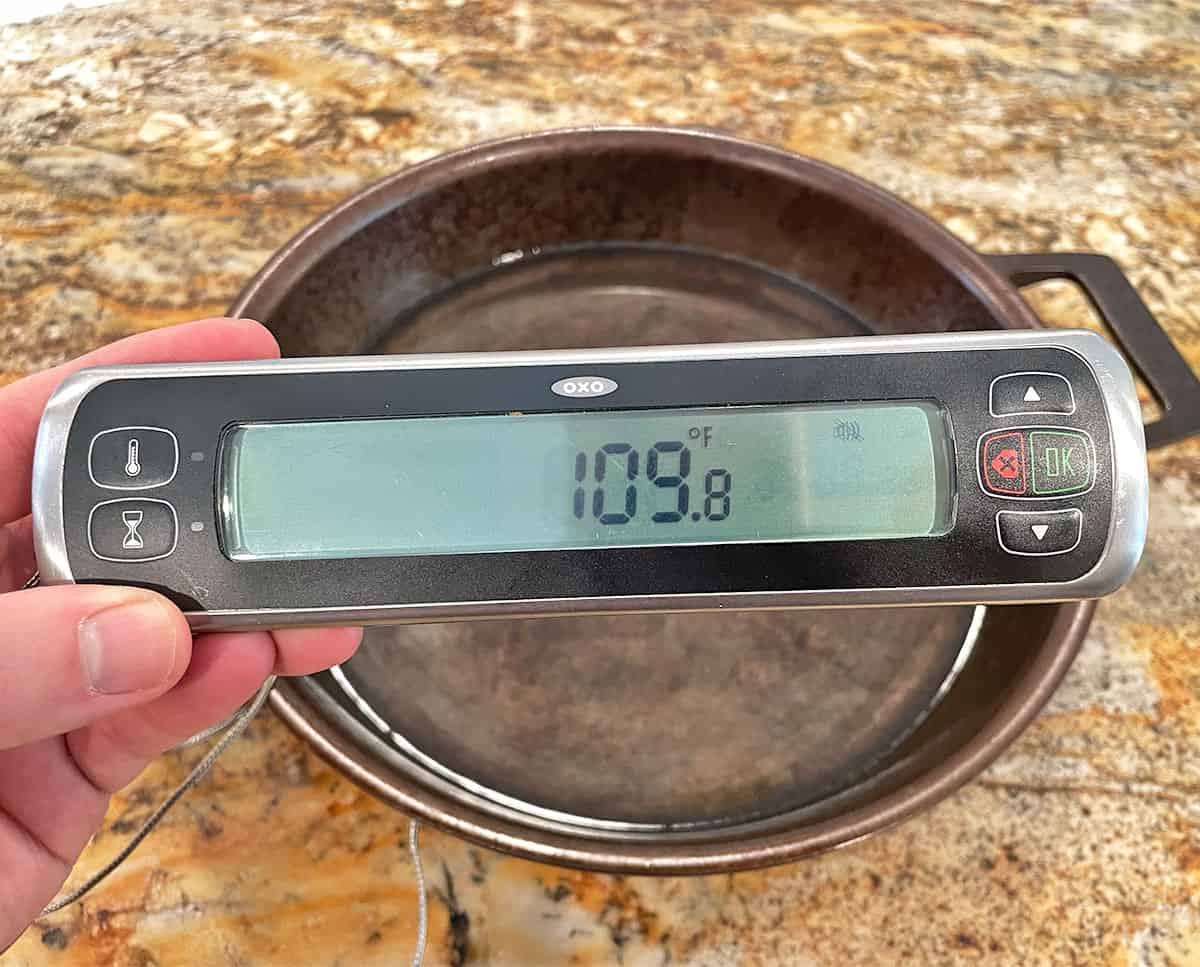
Again, I repeated this test with Lodge and Calphalon skillets. Here are the full results:
| Cast Iron Skillet | Temperature After 5 Minutes | Temperature After 10 Minutes |
|---|---|---|
| Stargazer | 124°F | 109°F |
| Lodge | 131°F | 116°F |
| Calphalon | 125°F | 109°F |
The Lodge skillet retained heat better than Stargazer and Calphalon, but all three performed well. I’m not surprised Lodge kept the water warmer because its skillets are slightly thicker, and thicker skillets usually absorb and retain heat better.
Sizes
Stargazer only offers three cookware pieces: a 10.5-inch skillet, a 12-inch skillet, and a 13.5-inch braiser. That said, the braiser launched recently, indicating that Stargazer may add new pieces.
Although their current collection is limited, these are the most common cast iron skillet sizes suitable for most meals.
Weight
Stargazer skillets are lighter than cast iron cookware from other brands.
While the 10.5-inch skillet’s weight is comparable to competitors, the larger 12.5-inch skillet and 13.5-inch braiser are significantly lighter.
The lighter weight makes a noticeable difference when using them. For example, if you need to carry the pan one-handed, it will put less strain on your wrist.
The chart below shows the weight of Stargazer skillets versus several other brands. As you can see, the Stargazer 12-inch skillet weighs less than Le Creuset, Calphalon, Lodge, and Backcountry skillets of the same size.
| Skillet Brand | Size | Weight |
|---|---|---|
| Stargazer | 10.5-inch | 5.2 lb |
| Stargazer | 12-inch | 6.5 lb |
| Stargazer | 13.5-inch | 7.5 lb |
| Le Creuset | 10.25-Inch | 5.4 lb |
| Le Creuset | 11.75-Inch | 6.8 lb |
| Calphalon | 12-Inch | 6.8 lb |
| Lodge | 10.25-Inch | 5 lb |
| Lodge | 12-Inch | 8 lb |
| Lodge | 13.25-Inch | 11.3 lb |
| Backcountry | 10-Inch | 5.8 lb |
| Backcountry | 12-Inch | 9.6 lb |
Materials and Construction
Stargazer skillets are precisely handcrafted out of recycled iron. The production begins in the company’s Wisconsin foundry, where the recycled iron is melted down and checked for purity.
The molten iron is poured into sand and clay molds and cooled. Once the molds are removed, the pans are sent to Ohio. A CNC (Computer Numerical Control) machine is used to ensure consistent thickness across all pans.
Finally, the pans are sent to Pennsylvania, where they are inspected and smoothed by hand. Some pans are seasoned, while others are bare (Stargazer offers both finishes). Once the pans are finished, they’re packaged and shipped to customers.
Some stock is also sent to their current only partner retailer, Cook Culture, which offers them in-store and online in Canada.
Company History
Compared to industry mainstays like Lodge, Stargazer is a relatively small company. It was founded in 2015 by Peter Huntley. He was a professional cookware designer for other American cookware companies and started to notice a decline in quality.
Upset by this trend, he quit his job to create Stargazer. All of Stargazer’s products are handcrafted. The company is proud to make its products in the U.S. rather than outsourcing the work overseas.
The company also incorporates sustainable practices throughout the production process. They use recycled cardboard for the boxes and recycled sand for the casting molds.
Price
There’s no sugarcoating it — Stargazer is expensive relative to other cast iron brands. The 10.5-inch skillet retails for $115, the 12-inch skillet is $145, and the 13.5-inch braiser costs $180.
In comparison, you could buy a quality Lodge skillet for less than half those prices (check out my comparison of Lodge vs. Stargazer).
So why is Stargazer more expensive?
The main reason Stargazer costs more is because of the manual steps involved. It’s not a mass-produced skillet made in a huge factory by machines.
Each piece is hand finished, seasoned, and carefully inspected. It takes time to produce one, but that attention to detail results in an heirloom-quality skillet you can pass down to the next generation.
Downsides
These are the downsides of Stargazer you need to know before buying.
Handle Design
The cup or U-shaped handle design reduces slipping when tilting the skillet, but it’s not the most comfortable to hold. The more you hold it, the more you’ll feel the edges digging into your hand.
Price
As mentioned, all Stargazer cookware retails for over $100. And, although Stargazer has features you won’t get with other brands, the difference in overall performance (heat conduction and retention) is marginal.
Lack of Variety
Another downside to Stargazer is the lack of sizes and options. Most cast iron cookware companies have many options, ranging from Dutch ovens to grill pans. Lodge, for example, offers a wok, a deep skillet, a griddle, and more. Their skillets come in nine sizes.
Stargazer, meanwhile, only offers 10.5 and 12-inch skillets and a 13.5-inch braiser. It’s not meant to be a one-stop shop for cookware — you’ll need to mix and match their skillets with other companies’ products for a complete set.
Seasoning Wears Off Quickly
The pre-seasoned skillets are seasoned with two coats of Stargazer’s signature oil blend, made using a combination of canola, grapeseed, and sunflower oils. However, these layers are applied thinly and quickly wear off. You need to apply one or two more coats before you start cooking or soon after.
What Others Say About Stargazer
Let’s review what other independent outlets say about Stargazer to get a broader perspective.
Serious Eats included the Stargazer 10.5-inch cast iron skillet in its list of the best cast iron skillets. The reviewers said Stargazer cast iron skillets are aesthetically pleasing with a bronze-like appearance.
They also praised the handle, saying it made the skillet easy to maneuver. However, the reviewers cautioned the skillet might be too heavy for some, and the lack of pour spouts makes removing liquids, like bacon grease, difficult.
Simply Recipes named Stargazer best overall in its list of the five best cast iron skillets. Contrary to Serious Eats, Simply Recipes said that the flared rim of Stargazer cast iron skillets made pour spouts unnecessary, and its pouring abilities outdid most other skillets (my experience aligned with this). The reviewers also praised the aesthetics, particularly the copper color.
Gear Patrol stated that Stargazer cast iron skillets are good all-around, but one stand-out attribute was the high-sloping walls. When you’re sauteeing veggies and flipping them around in the skillet, the oil won’t splash. Gear Patrol also said the front helper handle was easy to hold, even with an oven mitt.
New York Times Wirecutter included the Stargazer 12-inch cast iron skillet as a competitor to what it considers the best, the Lodge Chef Collection Cast Iron Skillet. The reviewers praised the depth of the Stargazer skillet, saying it was perfect for cooking dumplings or fried chicken.
Also, while it lacks pour spouts, Wirecutter said the rolled lip was more than sufficient for pouring out bacon grease without spilling it. The main point of criticism was for the handles, saying that they weren’t comfortable to hold.
Stargazer’s 10.5-inch cast iron skillet won People Magazine’s list of the four best cast iron pans. After frying an egg with one tablespoon of oil, no egg white residue was stuck to the skillet.
Its editorial team also tried cooking cornbread and searing steak. The cornbread cooked evenly, and the steak had a perfectly browned crust. They also praised the long forked handle, saying it stayed cooler for longer and made it easy to pick up and move around.
FAQs About Stargazer Cast Iron Skillets
Here are some answers to the most frequently asked questions about Stargazer cast iron skillets:
All Stargazer cast iron skillets are made in the U.S. The production process occurs in three states before shipping: Wisconsin (casting), Ohio (machining), and Pennsylvania (surface finishing).
Stargazer cast iron skillets come in two finishes: seasoned and bare. The skillet you choose will only come pre-seasoned if you select the seasoned finish.
To season your skillet, start by preheating the oven to 250 °F. While the oven is heating up, wash and dry the skillet thoroughly.
Once the oven is heated, place the skillet inside for 10 minutes to fully dry, take it out, and then preheat the oven to 475°F.
Spread a thin coat of oil across the entire skillet, including the handle. Choose an oil with a smoke point above 400°F with a neutral flavor. I typically use soybean oil, but canola, sunflower, and grapeseed work.
Once the oven’s temperature increases, place the oiled skillet back in the oven upside-down for an hour. Then, turn off the oven and let the skillet cool inside for an hour.
Repeat the process to add another layer of seasoning. It’s recommended to add at least two layers for longevity.
If you need more help, learn how I season my skillets in this quick video.
No, Stargazer cast iron skillets are not dishwasher safe. Always hand wash them in the sink using hot water and a sponge or chainmail scrubber. Too much soap can degrade the seasoning, so I recommend avoiding soap.
To clean your skillet, run it under hot water and scrub it with a soft sponge. Don’t use abrasive scrubbing pads like steel wool, which can wear down the seasoning and scratch the surface.
If there’s food stuck to the pan, mix kosher salt and water into a paste, then gently scrub it into the affected areas. If there’s still food stuck, heat the pan at a low temperature. The warmth should cause the food to loosen up, allowing you to wash it normally.
While you can soak other pans in the sink to clean them, do not do this with your cast iron skillet. Cast iron is prone to rust when water is left inside. When you’re done cleaning the skillet, dry it thoroughly with a soft microfiber towel.
To remove rust, scrub it off using a sponge and hot water. Re-season the skillet before using it again.
You can buy Stargazer cast iron skillets on StargazerCastIron.com or Amazon.
In the United States, Stargazer is sold directly to consumers on the company’s website. Canadian customers can buy Stargazer online or at
Cook Culture, a retailer with two physical stores in British Columbia.
Yes, all Stargazer cast iron skillets come with a lifetime warranty. This warranty covers manufacturer defects but not user error. Natural wear-and-tear is also not covered, so you can’t get a new pan if your old one is rusty or needs to be re-seasoned.
Bottom Line: Is a Stargazer Cast Iron Skillet Worth It?
Now that you know the pros and cons of Stargazer cast iron skillets, it’s time to decide if they’re right for your kitchen.
Before I provide my recommendation, let’s recap the key points:
- Stargazer skillets have unique design features, including a bronze-colored seasoning, long handles, flared rims, and a smooth cooking surface.
- They perform excellently in the kitchen. It’s the perfect skillet for searing, browning, roasting, and frying.
- Stargazer skillets heat up faster than Lodge, but the heat retention is slightly inferior due to its thinner walls.
- Stargazer skillets are lighter and easier to maneuver than many other brands.
- The main downsides are the higher price, uncomfortable cup-shaped handles, and thin factory seasoning.
Bottom line — With Stargazer, you get a lighter skillet, smoother surface, longer handles, and drip-free flared rims. If you value these features, it’s well worth the higher price. Cast iron cookware lasts forever, so it’s worth spending more to get something you’ll love for decades.
If you prefer a more traditional skillet with a shorter handle, pour spouts, and bumpier surface, Lodge and Calphalon are two inexpensive options.
If you’re ready to buy or just want to read other reviews, head over to StargazerCastIron.com or Amazon. They have pages that show how the skillets are made and the story behind the brand.
Related Topics
- Stargazer Cast Iron Review (Video)
- Stargazer vs. Lodge: Which Cast Iron Skillets Are Better?
- Best Oven-Safe Skillets: Top 5 Reviewed
- Lodge Classic vs. Chef Collection: Which Skillet Is Better?
- Smithey vs. Lodge Cast Iron: Is the Pricier Skillet Better?
- Are Lodge Cast Iron Skillets Any Good? An In-Depth Review
- Lodge Dutch Oven In-Depth Review: Pros and Cons You Need to Know
- 4 Best HexClad Cookware Alternatives
- Lodge vs. Tramontina: Which Dutch Ovens Are Better?
- Cast Iron Skillet Sizes: A Guide to Help You Choose
- Lodge vs. Le Creuset Dutch Ovens: What’s the Difference?
- Staub vs. Lodge: Which Dutch Ovens Are Better?
- Can You Use a Cast Iron Skillet on an Electric Glass Top Stove?
- Pros and Cons of Cast Iron Cookware



I wonder about where the recycle iron is from, because I get a weird metallic taste in the food. I have used it about 20 times mostly for cornbread.